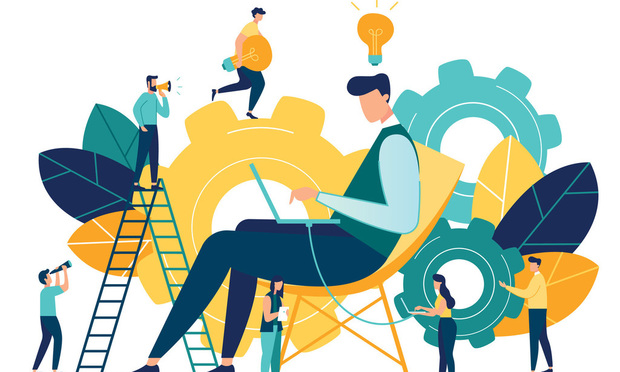For Law Firms, Design Thinking Offers a New Way Forward
Design thinking is an innovation methodology composed of a series of steps for generating options, testing strategies and getting feedback.
November 05, 2018 at 10:14 AM
5 minute read

Hospitals, airlines, retail, newspapers—every industry has been affected by the myriad advancements in technology in recent years. Developments like artificial intelligence and promising applications such as Watson and ROSS are impacting many professions, including the legal industry. These advancements are exciting but can be a little scary. Will robots take over our jobs? Should law firms invest heavily in research and development labs to stay ahead? Will lawyer jobs completely go away or will we see a dramatic lessening of demand?
While it's normal to question these things, technological advancements should never be taken as a threat. Technology will always fall short of interpreting, processing and delivering human emotion, which are critical components of building trust and doing business. Even if computers show emotions in the future, they will not be able to replicate quality human interaction.
Rather than being viewed as a threat, technology should be seen as an opportunity and a continuation of legal work. The deployments of new technologies are plenty, and they are not going away. But don't rush to invest in new technology without a sound decision-making process. Finding the right balance between tech and humans can be challenging. Design thinking is a strategy that is fast emerging in the legal industry. It is an innovation methodology composed of a series of steps for generating options, testing strategies and getting feedback. Done right, it can help organizations adapt to both technical and industry challenges using structured analysis to feed decision-making.
So how can the legal industry learn from this and offer client-centered solutions?
Companies like Apple Inc., Samsung, PepsiCo, Google and General Electric have already embraced the concept of design thinking, and it's now catching on in the legal industry, as evidenced by Stanford Law School's Legal Design Lab. But it's still in the infancy stage in law firms while very much alive in other industries. Margaret Hagan, the director of Stanford's lab, first thought of bringing the design concept into the equation of law to highlight “usable, useful and engaging” legal information, products, services, organizations and systems. Her model involves five deliberate steps: discover, synthesize, build, test and evolve. It can be applied to small- or large-scale projects depending on the issue one is trying to solve.
The 5 Stages of Design Thinking
- Discover: The first stage of the design thinking process is to understand the problem. This is the step where designers gather as much information as possible to gain insight.
- Synthesize: During this stage, designers work together to define the problem and create a statement. This stage will help to establish functions and dive deeper into the problem. In this stage, designers will start to progress to the third stage, “build,” by asking questions that can lead to solutions.
- Build: During the third stage of the design thinking process, designers begin to generate and build ideas. At this point, designers have grown to understand the needs and issues at hand. They can expand the problem space and come up with ideas.
- Test: During the test stage, designers start to test prototypes in live situations, giving them the possibility of investigating the solutions generated in the previous stage. These tests allow identification of the best possible solution for each of the problems identified during the first three stages. By the end of this stage, the designers will have a better idea of the end product.
- Evolve: During the last stage, the designers move forward and vet their solutions. It is possible that even during this phase, alterations and refinements are made to rule out solutions and derive as deep an understanding of the product and its users as possible.
Evolution of Design Thinking
Hagan used the design thinking methodology to help the legal industry in a practical and structural way. She wanted to improve the changing legal system and provide better access to justice, consumer law and training for the new generation of lawyers. In 2013, she began working on solutions to make legal services more usable and engaging. Already, the Legal Design Lab has started tracking what good consumer law looks like—what consumers do and don't like—which helps to enhance the delivery systems for legal services in the future.
“Right now, we are designing and testing short design sprints, and we are teaching the process, not the technology,” Hagan says. “While its's too soon to report results, we see it as a great potential for advancing the changing legal system.” Some firms have already embraced this idea and have seen success, including Baker McKenzie, with its Whitespace Legal Collab, Faegre Baker Daniels and Australia's King & Wood Mallesons.
Hagan's lab is also tracking why innovation goes wrong in law firms and has found three reasons:
- Law firms make and invest in things they think they should use but they don't use.
- Law firms get stuck in planning, thinking and theater without making an impact.
- Law firms jump straight to solutions, investing in the first promising idea.
While design thinking may still be in its infancy in the legal industry, it is a promising and creative approach to improve client service and help push the legal community to a new era of innovation. Additionally, firms that practice these skills regularly are found to be more collaborative, productive and effective. As Albert Einstein is credited with saying, “We can't solve problems by using the same kind of thinking we used when we created them.”
Ioana Good is the senior business development and communications manager for Lowndes, Drosdick, Doster, Kantor & Reed in Orlando. Contact her at [email protected].
This content has been archived. It is available through our partners, LexisNexis® and Bloomberg Law.
To view this content, please continue to their sites.
Not a Lexis Subscriber?
Subscribe Now
Not a Bloomberg Law Subscriber?
Subscribe Now
NOT FOR REPRINT
© 2025 ALM Global, LLC, All Rights Reserved. Request academic re-use from www.copyright.com. All other uses, submit a request to [email protected]. For more information visit Asset & Logo Licensing.
You Might Like
View All

Three Akin Sports Lawyers Jump to Employment Firm Littler Mendelson

Brownstein Adds Former Interior Secretary, Offering 'Strategic Counsel' During New Trump Term
2 minute read
Trending Stories
Who Got The Work
J. Brugh Lower of Gibbons has entered an appearance for industrial equipment supplier Devco Corporation in a pending trademark infringement lawsuit. The suit, accusing the defendant of selling knock-off Graco products, was filed Dec. 18 in New Jersey District Court by Rivkin Radler on behalf of Graco Inc. and Graco Minnesota. The case, assigned to U.S. District Judge Zahid N. Quraishi, is 3:24-cv-11294, Graco Inc. et al v. Devco Corporation.
Who Got The Work
Rebecca Maller-Stein and Kent A. Yalowitz of Arnold & Porter Kaye Scholer have entered their appearances for Hanaco Venture Capital and its executives, Lior Prosor and David Frankel, in a pending securities lawsuit. The action, filed on Dec. 24 in New York Southern District Court by Zell, Aron & Co. on behalf of Goldeneye Advisors, accuses the defendants of negligently and fraudulently managing the plaintiff's $1 million investment. The case, assigned to U.S. District Judge Vernon S. Broderick, is 1:24-cv-09918, Goldeneye Advisors, LLC v. Hanaco Venture Capital, Ltd. et al.
Who Got The Work
Attorneys from A&O Shearman has stepped in as defense counsel for Toronto-Dominion Bank and other defendants in a pending securities class action. The suit, filed Dec. 11 in New York Southern District Court by Bleichmar Fonti & Auld, accuses the defendants of concealing the bank's 'pervasive' deficiencies in regards to its compliance with the Bank Secrecy Act and the quality of its anti-money laundering controls. The case, assigned to U.S. District Judge Arun Subramanian, is 1:24-cv-09445, Gonzalez v. The Toronto-Dominion Bank et al.
Who Got The Work
Crown Castle International, a Pennsylvania company providing shared communications infrastructure, has turned to Luke D. Wolf of Gordon Rees Scully Mansukhani to fend off a pending breach-of-contract lawsuit. The court action, filed Nov. 25 in Michigan Eastern District Court by Hooper Hathaway PC on behalf of The Town Residences LLC, accuses Crown Castle of failing to transfer approximately $30,000 in utility payments from T-Mobile in breach of a roof-top lease and assignment agreement. The case, assigned to U.S. District Judge Susan K. Declercq, is 2:24-cv-13131, The Town Residences LLC v. T-Mobile US, Inc. et al.
Who Got The Work
Wilfred P. Coronato and Daniel M. Schwartz of McCarter & English have stepped in as defense counsel to Electrolux Home Products Inc. in a pending product liability lawsuit. The court action, filed Nov. 26 in New York Eastern District Court by Poulos Lopiccolo PC and Nagel Rice LLP on behalf of David Stern, alleges that the defendant's refrigerators’ drawers and shelving repeatedly break and fall apart within months after purchase. The case, assigned to U.S. District Judge Joan M. Azrack, is 2:24-cv-08204, Stern v. Electrolux Home Products, Inc.
Featured Firms
Law Offices of Gary Martin Hays & Associates, P.C.
(470) 294-1674
Law Offices of Mark E. Salomone
(857) 444-6468
Smith & Hassler
(713) 739-1250









